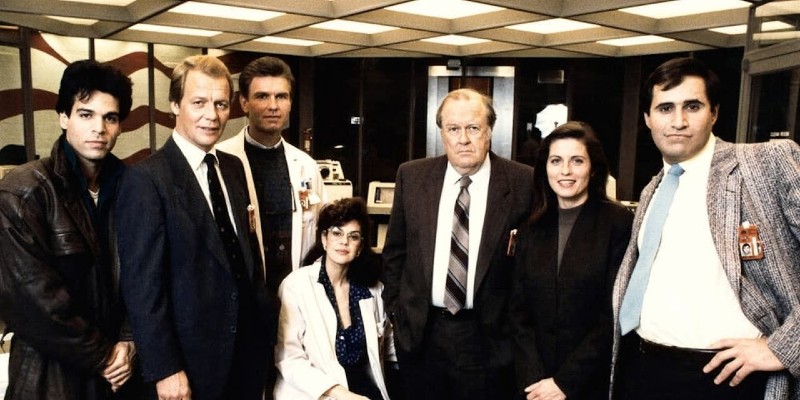Back when I was a newspaper reporter, I was hanging around our local prosecutor’s office when an investigator for the prosecutor was fondly recalling his days as a police officer and how cops would interrogate someone by holding their head underwater in the toilet in a police holding cell.
I thought of that moment when I was re-watching an episode of “UNSUB,” a 1989 crime drama, and David Soul, as the leader of a high-tech investigative unit, reassures M. Emmet Walsh, playing an old-school cop assigned to the unit, “We keep you around here to remind us of how things used to be. You’re the only cop that keeps rubber hoses in his desk.”
“UNSUB” might have but did not lead a trend in a new style of criminal investigative series. It was hugely indebted to the 1986 thriller “Manhunter,” which was adapted from Thomas Harris’ 1981 novel “Red Dragon,” the debut of Hannibal Lecter. “UNSUB” preceded by a decade the “CSI: Crime Scene Investigation” franchise that began in 2000 and continues to this day.
“UNSUB” might have failed to find an audience because it was ahead of its time. Or maybe it was just a failure, as we are not seeing “UNSUB: Las Vegas” and “UNSUB: Tallahassee” all over our screens. But it’s an interesting failure.
“UNSUB” wasn’t entirely the first of its kind, but for its time, it was unusual.
The Case of the Fingerprint in the Night-Time
There’s a long history of science-based detective work in fiction and the first that comes to mind is Sherlock Holmes’ monographs on types of cigar ash and his other scholarly pursuits of bad guys. The late 1800s were a time of incredible advances in science as it was portrayed in fiction – despite pesky little missteps like Bram Stoker’s use of what seems like every character in “Dracula” to give every other character a blood transfusion, regardless of blood type.
Reality had to catch up with fiction and fiction had to stop outpacing reality: Fingerprint evidence wasn’t used in a murder trial until 1910, when Thomas Jennings was convicted after leaving a fingerprint behind in fresh paint at a Chicago crime scene. Smithsonian Magazine wrote about the case in 2018 and noted that the science of fingerprint identification had been popularized in England but had yet to gain acceptance in the United States.
Scientific detection outstripped the domain of Holmes and the courts and became a staple of books, stories, movies and TV. Heck, in DC Comics books about the Flash – and the subsequent TV series – the Scarlet Speedster’s secret identity, Barry Allen, was a crime scene investigator.
Beginning in 1976 with the TV series “Quincy, M.E.,” the forensic sciences were demonstrated weekly in viewers’ living rooms, with crusty Jack Klugman as the crusty medical examiner for Los Angeles County. The show, which ran until 1983, helped pave the way for viewers who would, in 2000, embrace the world of crime scene investigators, a CSI-verse that has now grown to five shows and some imitators.
But it was in “Manhunter” – and later “UNSUB” – that we saw the practice of showing investigators scrutinizing a crime scene and analyzing minute clues paired with a “get inside the killer’s head” trope.
I’ll admit I roll my eyes a little at the moments in the Michael Mann-directed “Manhunter” when William Peterson, as FBI profiler Will Graham, “got inside the head” of serial killer Francis Dollarhyde by walking around in a dark house, proclaiming things like, “That’s how you did it, isn’t it, you son of a bitch!” The movie is top-notch, though, and benefits from a brief but mesmerizing appearance by Brian Cox as Hannibal Lecter.
It was probably inevitable that we’d see a “get inside the killer’s head” guy in “UNSUB.”
Creepy killers galore
“UNSUB” – the name is short for “Unknown Subject” – had a pretty good pedigree. It was developed by uber-producer/author Stephen J. Cannell, who’s credited with creating “The Rockford Files,” “The A-Team” and other series. His shows are easily identifiable by Cannell’s production tag after the credits, in which he pulls a piece of paper from his typewriter and throws it into the air, only for it to become animated and turn into his production company logo.
The camera-facing talent was experienced too. David Soul, who had co-starred in “Starsky and Hutch,” played the “UNSUB” lead, John Westly Grayson, who oversees an special FBI team of scientists and former cops: the aforementioned Walsh, one of our great character actors, as the set-in-his-ways ex-cop, “Adam-12” co-star Kent McCord as a lab genius and Jennifer Hetrick, who dependably showed up on a couple of latter-day “Star Trek” series as well as “Buffy the Vampire Slayer” and “Alias,” as a field investigator.
Another member of the team was an echo of the Will Graham character from “Manhunter.” Tony D’Agostino, played by Joe Maruzzo, was the designated investigator who would return to crime scenes late at night and walk around, trying to put himself in the mindset of the killer.
In the first episode, the team dons head-to-toe “clean” gear – which viewers might have been more accustomed to seeing in the operating room where “The Six Million Dollar Man” was created – to find clues at and avoid contaminating a crime scene.
Their methods are effective, but Grayson notes that local police investigators around the country are happy to hand off their most baffling cases to the team – and then blame them when they can’t produce anything helpful from a crime scene that local cops have already trampled.
Episodes feature a mime who works children’s birthday parties and uses a rabbit to lure kids to his car, and one with Kevin Spacey as a killer tormented by uncleanliness. So, plenty of creepiness in these episodes, all of which can be found online.
“UNSUB” never drew many viewers and only lasted eight episodes before it was canceled. A few newspaper columnists noted in 1989 that the Emmy category of achievement in main title theme music was the kiss of death that year, with “UNSUB,” “Knightwatch,” “Men” and “Tattingers” all canceled before the ceremony came around in the fall. The fifth nominee, “Paradise,” didn’t last much longer.
But the ground that “UNSUB” broke – scientific investigations of crime – would become a popular path soon.
The CSI effect
“Silence of the Lambs,” based on Thomas Harris’ riveting book, took audiences by storm in 1991, just two years after “UNSUB” failed. The film, directed by Jonathan Demme, provided vehicles for stars Jodie Foster as FBI trainee Clarice Starling and Anthony Hopkins as Hannibal Lecter, a psychologist, serial killer and cannibal. The whole movie is among the best cat-and-mouse games on film, taken to its highest level by the leads. It is the movie that launched a thousand parodies. And controversies, as the Buffalo Bill character has been interpreted by many as a slam at transexuals. It’s a hard criticism to refute. But in Hollywood, success means never having to say you’re sorry, and sequels and prequels and new adaptations followed.
By 2005, when the series “Bones” debuted, forensics and scientific police investigations were so common in movies and TV that audiences came to find them as comforting as Columbo’s rumpled overcoat. In 2021, CBS aired “Clarice,” a set-in-the-same-time-period, direct sequel to “Silence of the Lambs,” with Rebecca Breeds as Clarice Starling, struggling to get back into a routine investigative routine after her encounters with Buffalo Bill and Hannibal Lecter. (The one thing the series could not do: mention Lecter by name since the rights to the character belonged elsewhere.) Clarice worked with an “UNSUB”-like group of investigators to bring a seeming serial killer to justice. Their efforts included not only scientific methods but “get in the killer’s head” tactics.
After all, were you even investigating a crime if you weren’t using scientific methods? Apparently not, because something called “the CSI effect” was sometimes cited by real-world investigators. In 2004, USA Today reported that criminal trial jurors accustomed to the miracles of forensic detection on TV thought real-word prosecutors should have more scientific evidence to close their cases.
A 2008 article for the National Institute of Justice noted that the “C.S.I.” shows were among the most popular dramas around the world. The author of the article, Judge Donald E. Shelton, noted, “I once heard a juror complain that the prosecution had not done a thorough job because ‘they didn’t even dust the lawn for fingerprints.’ As one district attorney put it, ‘Jurors now expect us to have a DNA test for just about every case. They expect us to have the most advanced technology possible, and they expect it to look like it does on television.’”
Shelton said that, ultimately, there was little evidence that juries would convict or acquit criminal defendants based on scientific evidence – or the jurors’ viewing habits. But he wrote, “Most importantly, prosecutors, defense lawyers, and judges should understand, anticipate, and address the fact that jurors enter the courtroom with a lot of information about the criminal justice system and the availability of scientific evidence. The bottom line is this: Our criminal justice system must find ways to adapt to the increased expectations of those whom we ask to cast votes of ‘guilty’ or ‘not guilty.’”
As the co-author of four true crime books, I can tell you that readers will ask at book signings about the use of forensic or scientific evidence to solve any of the unsolved murders in our books. People have an expectation that any crime is solvable if CSIs can find a fingerprint or DNA sample. The truth is that until the last couple of decades, many police investigators didn’t know about proper collecting or preservation of such evidence. They didn’t understand the importance of it, and any DNA evidence, for example, that might have been present at the scene wasn’t collected, or it became compromised in the investigation.
If “UNSUB” had been a typical Stephen J. Cannell hit, perhaps the phrase “CSI effect” might have been “UNSUB effect” instead.

















